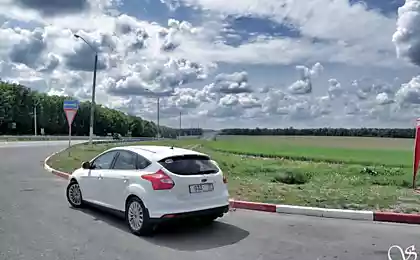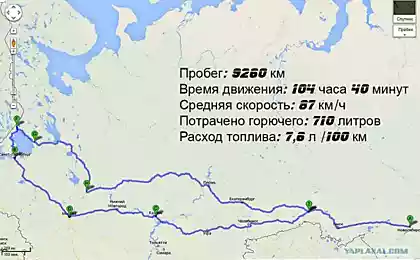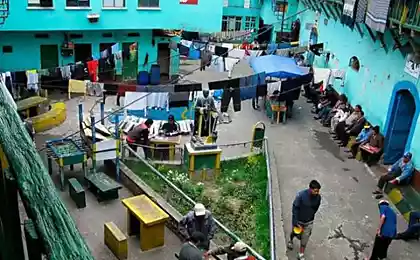1528
Photo excursion
From the author Vitaly Raskalova:
A little less than a month together with Vadim Mahorovym returned from a trip to Central Asia, our main goal was to pass through Uzbekistan and Tajikistan to Afghanistan itself.
This is one of the few trips where our main goal was not polazki on roofs, subway and other city attractions, and find out why in Russia such a strong influx of immigrants from Uzbekistan and Tajikistan, do they have at home everything is so bad that the only way out for them this immigration to neighboring Russia.
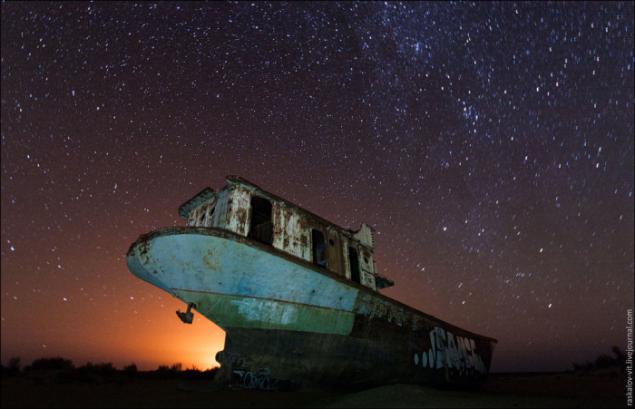
Our journey started from Uzbekistan and its capital city of Tashkent. Our original plan was to drive from Tashkent to Nukus, and from there along the southern part of the country through Khiva, Bukhara and Samarkand get to Tajikistan.
This tour turned out that way. All who wish to repeat my advice to you is better to fly to Nukus, and from there along the southern part of the country to Tashkent, so you will save a decent amount of money.

In Tashkent, there is nothing, nothing at all here - from the beautiful architecture here is worthy only hotel "Uzbekistan", built during the Soviet era. So we stayed here just for two days.

On one of the main markets of the city stumbled upon this beauty, it turns out, is a neglected part of the bazaar. By the way, you can buy on the market, common in Central Asia, and now in Russia nasvay. Here he chew everything from teenagers to the elderly, the price is around 5-6 dollars per kilogram.

Since I planned this trip as budget, we have to advance a sleeping bag and a tent, did not need to use hotels and spend the night where we please.
Weather permitting, so we chose to stay overnight near the roof of the city TV tower, in my opinion, the only attraction of this city. At the top of the TV tower is an observation deck and a restaurant on the type of Ostankino "7th Heaven", to our regret, due to the replacement lift access to the tower was closed.

Climb on the roofs of the city is quite useless. First of all the buildings in the city are identical, only in the second tallest building here - it is a hotel of Uzbekistan, and even then, we even did not let her inside.
4. Tashkent Circus.

5. In Tashkent, there are meters, consisting of three branches and 29 stations. Local Metro, we used only a few times, but when we found ourselves in a radius of some of the stations, the local police have checked several times examined the documents and all the contents of backpacks. And most of them ask me and Vadim where our visas. Employees who understand the Russian language each time were very surprised when they learned that a visa in their country for the majority of citizens of the CIS is not required.
Dialogues with local law enforcement in most cases looked like.
- Where a visa?
- For the citizens of Russia and Ukraine visa to your country is not required.
- It is not required? Do you need a visa, where the visa brother?

The local metro is strictly forbidden to shoot at each duty station for at least two police officers. So we went to look for other ways to make photo subway to get into existing tunnels we have failed, but in the abandoned part of the Metro construction is very easy, however, there is absolutely nothing to do.

After spending two days in Tashkent, we flew by plane to Nukus. We flew on the IL-114, in the civil aviation of the world there are only 7 units, 5 and 2 in Uzbekistan in Tajikistan. After landing at the airport in the afternoon Nukus, we started to look for transport to Muinak.

Muinak the nearest town to the Aral Sea. Once it was an island, and until the 1980s there was a port in the city on the southern shore of the Aral Sea. Currently, the port has become a graveyard of ships.
As of 2013 Muinak from about 150 km to the west (deep) of the South Aral Sea and about 180 km to the east (shallow) part. The eastern part of the sea (due to the relatively shallow depths), the fastest retreating from Muinak: in the mid-1990s, it was at a distance of 45 km from the city, and in the early 2000s - at a distance of 100 km.
The central street Muinak.
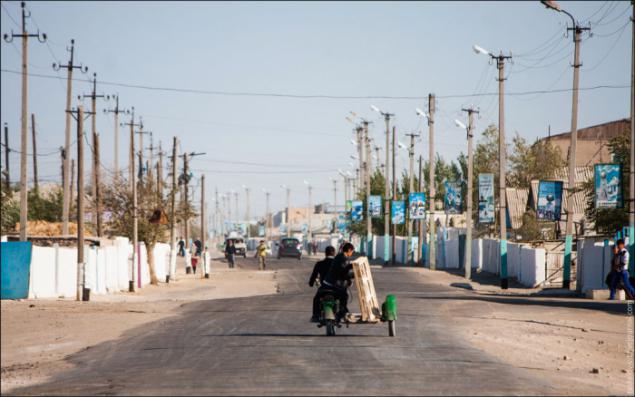
Before we reached the city late at night, and found the only one in the county guest house, the price for two was about 1000 (Russian rubles) at our disposal was a house and a free dinner and breakfast. Owners of the house turned out to be friendly, they told us about the Aral Sea, and before it could reach.
The biggest challenge to get to the beach, is the lack of roads and remoteness, are needed not just a machine, namely SUV-type "UAZ", as most of the way to be overcome on the former seabed. From local, we learned that in the city there is only one person who carries to the Aral Sea. It turned out to be a Russian man named Vladimir Zuyev, who is over 60 years since he had no competitors, to bargain with us was not possible. Tour price per person was 100 $.
Former Port Muinak.



The rate of withdrawal of water from the sea: 1960x - 1990x - 2009.

The path to the sea was not a short, off-road 150km overcome in the best case for 4-5 hours. The average speed of about 20-30 km. The bottom of the sea rich in minerals, the first 30-40km way our route ran past the gas towers, has already begun on the desert landscape.

In the best of times there was a depth of 20 to 30 meters. On the horizon you can see the Ustyurt plateau.

Aral Sea is drying up is the fourth area of the lake in the world. The degradation of the Aral Sea began in 1960, when most of the flow of the Amu Darya and Syr Darya began to climb through the canals for irrigation and household needs of Turkmenistan, Uzbekistan and southern Kazakhstan. As a result, the sea retreated significantly from its shores, and stripping the bottom, covered with sea salt with a mixture of pesticides and other chemicals.
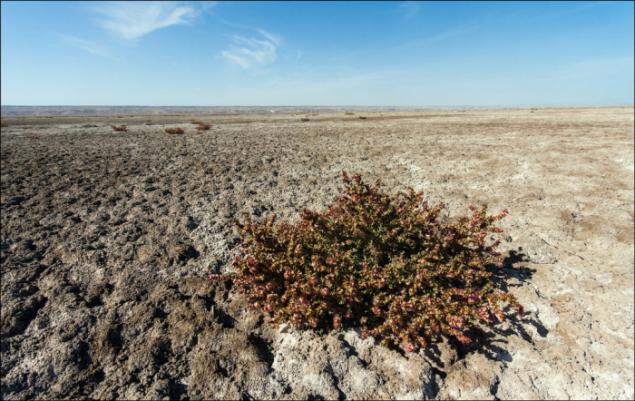
The Aral Sea, we swam in it. Because of the strong concentration of salt in the sea to drown in it impossible.
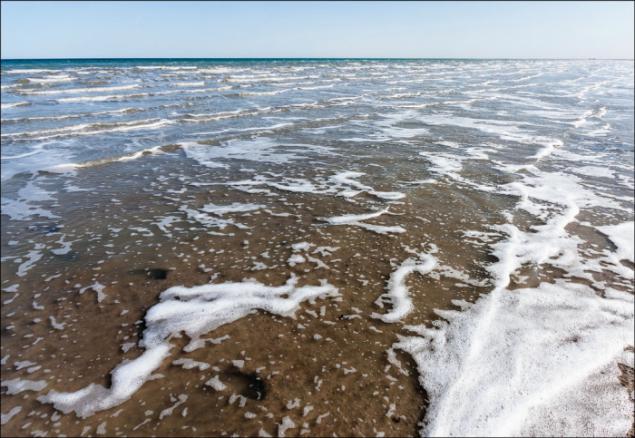
When planning a visit to the Aral Sea, we also wanted to get to the former "island of Renaissance" - which for 50 years operated a top-secret biochemical testing ground "Dune." The island also has a closed military town of Aralsk-7 (Kantubek) - Floor area test site, where the population of 1, 5 thousand people.
For fifty years, we were tested microbiological (bacteriological) weapons in experimental animals (rats, horses, dogs, monkeys). Samples of products for biological tests were delivered to the island from all military biochemical laboratories of the USSR. In the northern part of the island in the early 1960s it was built a military airfield, which consists of four runways (the original ground) as the wind rose. In the 1980s, the airport runways were equipped with a coating of concrete slabs.
Landfill operated until 1992, then troops (and their families) was relocated to Russia biolaboratoriya - dismantled part of the military equipment was taken, and some remained buried on the island.
After the closure of the lab visited the island group of experts of the Pentagon, as well as numerous scientific expeditions.
To get to it, we could not, because of the fact that close to the island recently found oil and the area under the control of the military took Uzbekistan. Access to the island is limited, though, I do not exclude the possibility to get to it from the Kazakh side.

Seashore clay, feet fail. Just like at the Dead Sea, the clay is considered to be curative.

A strange feeling you're sitting by the sea, which may have 10 years no longer.

Local landscapes.

Near the beach tents are with the workers, in which miners settled brine shrimp eggs. Protein-rich shrimp used as fish feed or food supplement for cattle.
They work in shifts for the men two weeks. Collecting bags copepod eggs that are smaller than sand, workers receive 100 to $ 300 depending on the catch.

Uncle Volodya and our new friends made us a local vodka, refuse this offer impossible perceive as disrespect.

Thus ended the Aral Sea.
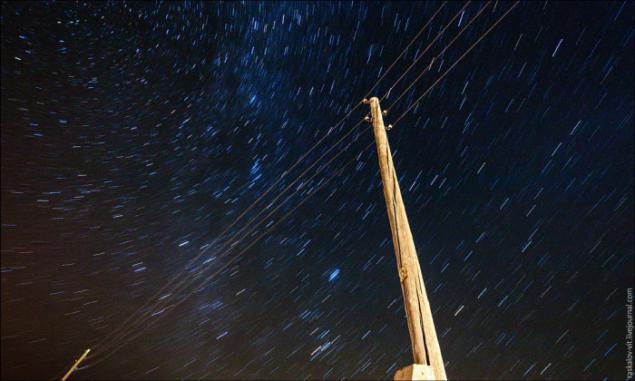
From Muinak we had a goal to get to Khiva, as it turned out done by bus or plane - is practically impossible, at least we say so taxi drivers. Before turning to the local "fish is" we decided to ask local rates for one place to Khiva, the prices were more than acceptable, the price per person varied local from 15 thousand up to 20 million, that is, for two will receive a maximum of 40 thousand.

With optimistic we went to look for a vehicle with Muinak to Khiva or in extreme cases to Urgench, close the nearest town which is only 20 kilometers away from the destination.
Our optimistic cleared immediately at the first questioning, it turned out to Khiva generally do not travel, and to Urgench price per person will be a minimum of 100 thousand sums (!). Few porazmyshliv, decided to try to get to Nukus, and from there look for a more profitable option of transport to Khiva.
The guy who picked us up from the Muinak Nukus, was very good-natured and decided to help us to agree on the normal price for transport to Khiva. Work colleagues did not appreciate his initiative "to help visitors" and after a few minutes of casual conversation began to grow almost in a fight. As a result, it was over the fact that we were asked to go to Khiva for 60 thousand person, local price is 2.5 times cheaper. Naturally such an option does not suit us and we decided to get to Khiva us anything except a taxi, it was decided to go to the bus station, and then get out on the bus.
It is said that the taxi drivers in Uzbekistan is the most disgusting people, not knowing the Uzbek language to go from town to town on 'local' prices impossible. First - the local "fish is" do not like to travel long distances, so they usually offer a drop off to the nearest large city, but already there is your car. The trick is that they are actually re-sell you to others and that taxi drivers have a good percentage, sometimes even more than your new driver. The second point - you pay only for their place, that is, that would leave you enough to find a car, you still have to wait for three people, and only then the car will go.
Replacing several buses and even a trolley, almost 10 hours we got to Khiva. The city came late in the evening, the bus driver helped us with finding housing and around $ 4 per person per night, we settled in the guest house directly opposite the walls of the fortress.

Khiva - the city on the Silk Road. Inside Khiva is very ancient city, surrounded by high mud walls - Ichan-Kala. In fact, this place is a museum city, because everything in it - from the streets before any building is historic. Surprisingly, and that in fact it is a closed city, which still lives of 4000 people, the descendants of a wealthy or famous people of that time.
One of the main attractions is a minaret 70 meters from there is a great view of the city.


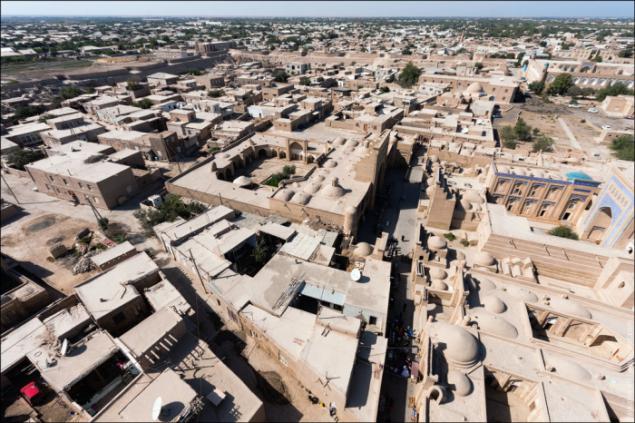

Kalta Minar minaret, which was supposed to be the tallest minaret in Uzbekistan, but these plans were not destined to come true. After the death of the architect, construction was halted. In general, in this respect, there are many legends. One of them says that when the Bukhara Khan learned of the audacious plan to build the highest minaret (and at that time the highest was just in Bukhara), he ordered the architect to kill, and it seemed he was thrown from that of the minarets.
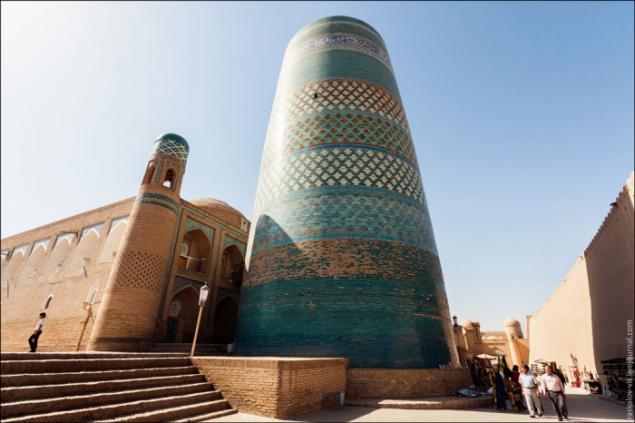

Khiva is remarkable in that all of its major attractions are nearby and you can get around them for a few hours, so we stayed in the city exactly one day. The next day, early in the morning we went to Bukhara through the desert.

Bukhara is one of the oldest cities in Central Asia. Age of Bukhara more than 2,500 years. In ancient Bukhara was part of one of the regions of Central Asia - Sughd, where in the time of Alexander the Great was developed urban structure. After Bukhara Silk Road ran. There were more than 60 caravanserais, which housed merchants from India, China, Iran and other countries.




I liked least Bukhara and Khiva. Probably due to the fact that there are a huge number of tourists.

In Bukhara we also stayed only one day, after examining all the sights, we were supposed to meet with a familiar Uzbeks in Bukhara, with whom we were fortunate to meet at the airport of Tashkent. He promised us a ride to Samarkand, in fact, it was that he threw us. A whole day to feed us breakfast, and later had stopped taking the tube. Because of this situation, we missed the morning bus to Samarkand, and hang around another day in Bukhara not like we decided to try to get hitchhiking.
With hitchhiking in Uzbekistan all very well for the whole trip stop from Bukhara to the border of Tajikistan we have never stood for more than 5 minutes. Sometimes we do not even have time to raise his hand, as immediately we picked up the car.


In Uzbekistan, we spent more than a week, and time was running out to meet the 2 weeks, we had to cross the border quickly. What we actually do. Looking ahead, I want to say go Uzbek-Tajik border is perhaps one of the most difficult quests. To our misfortune is the convenient and fast border crossing "Pendjikent" for several years now closed for renovation. Our main problem was - a presumption, since this pogran passage is closed, so we just move along the border. Hitchhiked to Yangiyer, we learned that there pogran transition only to the military and we need to go to Bekabad, it was 60km east.
With jokes, rhymes reaching Bekabad, we were disappointed again - this transition was only for residents of nearby towns. On it you can go, but only if the Uzbek or Tajik passports. We turned around and headed back to the 80 km to the north kishlak Chanak supposedly there right on the road there is an international crossing. Gritting his teeth, we went back to the track where to catch the bus that we threw to the right pogran transition.
The border crossing took less than an hour, during this time the border guards on the Uzbek side several times offered us hang out with them and throw nasvay. We kindly refused.
As we crossed the border.

People have changed, the air became cooler - we finally ended up in Tajikistan.

Uzbeks do not like Tajiks, the mere fact that the entire border between the two countries undermined perfectly confirms this fact. The Uzbek government claims that such measures are necessary in order to from Tajikistan to Uzbekistan is not broke any radical movements of Islam. The funny thing is that even though Tajikistan, bordering Afghanistan, in the country for many years there are no such groups.
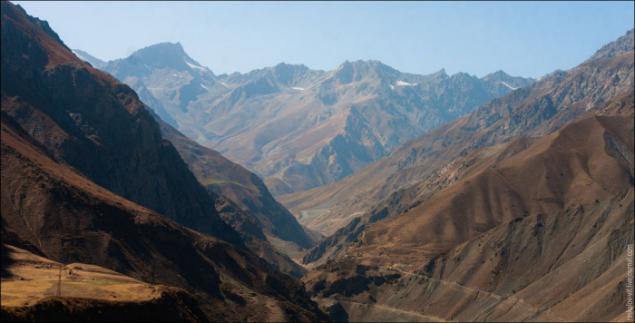
After crossing the border to the nearest large city of Khujand (Leninabad) was about 150km of mountain roads, at first we hoped that we will reach a self-locking, but we were almost the only ones that day crossed the border. Therefore, we again had to use the services of taxi drivers. Reaching the Khujand, we started looking for transport in Dushanbe, it turns out, because of the difficult mountain passes buses do not go to the capital and the only transport - is fucking unloved us a taxi.
We had a choice to stay in the city or try to get to Dushanbe. Just for fun decided to ask at the local transport costs. To our great luck we met peregonschiki machines that regularly travel from Khujand to Dushanbe. The road to the capital is very difficult, and it was necessary to go at night, they took us to a small fee, with the proviso that we will maintain a conversation with the driver to suddenly fall asleep. The money they took from us were exclusively for gas, gasoline and paying for roads. In Tajikistan, most of the roads are paid, cost from 20 to 100 rubles per portion. By the way, the roads in Tajikistan is better than in Russia.
Having arrived in Dushanbe late at night, we have sharply question of housing. One of peregonschikov named Hassan, kindly put us at for free. If you're reading this, thank you very much, my friend. In addition, he helped us find transportation to the border with Afghanistan, and showed the most beautiful lake in the back of the Fan Mountains Iskanderkul.
Fann Mountains.

Impressions of Tajikistan and its people much nicer than their neighbors. Here we are not trying to cheat, we did not look askance and asked every 10 minutes from where we are and what we do here.
km.
©
A little less than a month together with Vadim Mahorovym returned from a trip to Central Asia, our main goal was to pass through Uzbekistan and Tajikistan to Afghanistan itself.
This is one of the few trips where our main goal was not polazki on roofs, subway and other city attractions, and find out why in Russia such a strong influx of immigrants from Uzbekistan and Tajikistan, do they have at home everything is so bad that the only way out for them this immigration to neighboring Russia.

Our journey started from Uzbekistan and its capital city of Tashkent. Our original plan was to drive from Tashkent to Nukus, and from there along the southern part of the country through Khiva, Bukhara and Samarkand get to Tajikistan.
This tour turned out that way. All who wish to repeat my advice to you is better to fly to Nukus, and from there along the southern part of the country to Tashkent, so you will save a decent amount of money.

In Tashkent, there is nothing, nothing at all here - from the beautiful architecture here is worthy only hotel "Uzbekistan", built during the Soviet era. So we stayed here just for two days.

On one of the main markets of the city stumbled upon this beauty, it turns out, is a neglected part of the bazaar. By the way, you can buy on the market, common in Central Asia, and now in Russia nasvay. Here he chew everything from teenagers to the elderly, the price is around 5-6 dollars per kilogram.

Since I planned this trip as budget, we have to advance a sleeping bag and a tent, did not need to use hotels and spend the night where we please.
Weather permitting, so we chose to stay overnight near the roof of the city TV tower, in my opinion, the only attraction of this city. At the top of the TV tower is an observation deck and a restaurant on the type of Ostankino "7th Heaven", to our regret, due to the replacement lift access to the tower was closed.

Climb on the roofs of the city is quite useless. First of all the buildings in the city are identical, only in the second tallest building here - it is a hotel of Uzbekistan, and even then, we even did not let her inside.
4. Tashkent Circus.

5. In Tashkent, there are meters, consisting of three branches and 29 stations. Local Metro, we used only a few times, but when we found ourselves in a radius of some of the stations, the local police have checked several times examined the documents and all the contents of backpacks. And most of them ask me and Vadim where our visas. Employees who understand the Russian language each time were very surprised when they learned that a visa in their country for the majority of citizens of the CIS is not required.
Dialogues with local law enforcement in most cases looked like.
- Where a visa?
- For the citizens of Russia and Ukraine visa to your country is not required.
- It is not required? Do you need a visa, where the visa brother?

The local metro is strictly forbidden to shoot at each duty station for at least two police officers. So we went to look for other ways to make photo subway to get into existing tunnels we have failed, but in the abandoned part of the Metro construction is very easy, however, there is absolutely nothing to do.

After spending two days in Tashkent, we flew by plane to Nukus. We flew on the IL-114, in the civil aviation of the world there are only 7 units, 5 and 2 in Uzbekistan in Tajikistan. After landing at the airport in the afternoon Nukus, we started to look for transport to Muinak.

Muinak the nearest town to the Aral Sea. Once it was an island, and until the 1980s there was a port in the city on the southern shore of the Aral Sea. Currently, the port has become a graveyard of ships.
As of 2013 Muinak from about 150 km to the west (deep) of the South Aral Sea and about 180 km to the east (shallow) part. The eastern part of the sea (due to the relatively shallow depths), the fastest retreating from Muinak: in the mid-1990s, it was at a distance of 45 km from the city, and in the early 2000s - at a distance of 100 km.
The central street Muinak.

Before we reached the city late at night, and found the only one in the county guest house, the price for two was about 1000 (Russian rubles) at our disposal was a house and a free dinner and breakfast. Owners of the house turned out to be friendly, they told us about the Aral Sea, and before it could reach.
The biggest challenge to get to the beach, is the lack of roads and remoteness, are needed not just a machine, namely SUV-type "UAZ", as most of the way to be overcome on the former seabed. From local, we learned that in the city there is only one person who carries to the Aral Sea. It turned out to be a Russian man named Vladimir Zuyev, who is over 60 years since he had no competitors, to bargain with us was not possible. Tour price per person was 100 $.
Former Port Muinak.



The rate of withdrawal of water from the sea: 1960x - 1990x - 2009.

The path to the sea was not a short, off-road 150km overcome in the best case for 4-5 hours. The average speed of about 20-30 km. The bottom of the sea rich in minerals, the first 30-40km way our route ran past the gas towers, has already begun on the desert landscape.

In the best of times there was a depth of 20 to 30 meters. On the horizon you can see the Ustyurt plateau.

Aral Sea is drying up is the fourth area of the lake in the world. The degradation of the Aral Sea began in 1960, when most of the flow of the Amu Darya and Syr Darya began to climb through the canals for irrigation and household needs of Turkmenistan, Uzbekistan and southern Kazakhstan. As a result, the sea retreated significantly from its shores, and stripping the bottom, covered with sea salt with a mixture of pesticides and other chemicals.

The Aral Sea, we swam in it. Because of the strong concentration of salt in the sea to drown in it impossible.

When planning a visit to the Aral Sea, we also wanted to get to the former "island of Renaissance" - which for 50 years operated a top-secret biochemical testing ground "Dune." The island also has a closed military town of Aralsk-7 (Kantubek) - Floor area test site, where the population of 1, 5 thousand people.
For fifty years, we were tested microbiological (bacteriological) weapons in experimental animals (rats, horses, dogs, monkeys). Samples of products for biological tests were delivered to the island from all military biochemical laboratories of the USSR. In the northern part of the island in the early 1960s it was built a military airfield, which consists of four runways (the original ground) as the wind rose. In the 1980s, the airport runways were equipped with a coating of concrete slabs.
Landfill operated until 1992, then troops (and their families) was relocated to Russia biolaboratoriya - dismantled part of the military equipment was taken, and some remained buried on the island.
After the closure of the lab visited the island group of experts of the Pentagon, as well as numerous scientific expeditions.
To get to it, we could not, because of the fact that close to the island recently found oil and the area under the control of the military took Uzbekistan. Access to the island is limited, though, I do not exclude the possibility to get to it from the Kazakh side.

Seashore clay, feet fail. Just like at the Dead Sea, the clay is considered to be curative.

A strange feeling you're sitting by the sea, which may have 10 years no longer.

Local landscapes.

Near the beach tents are with the workers, in which miners settled brine shrimp eggs. Protein-rich shrimp used as fish feed or food supplement for cattle.
They work in shifts for the men two weeks. Collecting bags copepod eggs that are smaller than sand, workers receive 100 to $ 300 depending on the catch.

Uncle Volodya and our new friends made us a local vodka, refuse this offer impossible perceive as disrespect.

Thus ended the Aral Sea.

From Muinak we had a goal to get to Khiva, as it turned out done by bus or plane - is practically impossible, at least we say so taxi drivers. Before turning to the local "fish is" we decided to ask local rates for one place to Khiva, the prices were more than acceptable, the price per person varied local from 15 thousand up to 20 million, that is, for two will receive a maximum of 40 thousand.

With optimistic we went to look for a vehicle with Muinak to Khiva or in extreme cases to Urgench, close the nearest town which is only 20 kilometers away from the destination.
Our optimistic cleared immediately at the first questioning, it turned out to Khiva generally do not travel, and to Urgench price per person will be a minimum of 100 thousand sums (!). Few porazmyshliv, decided to try to get to Nukus, and from there look for a more profitable option of transport to Khiva.
The guy who picked us up from the Muinak Nukus, was very good-natured and decided to help us to agree on the normal price for transport to Khiva. Work colleagues did not appreciate his initiative "to help visitors" and after a few minutes of casual conversation began to grow almost in a fight. As a result, it was over the fact that we were asked to go to Khiva for 60 thousand person, local price is 2.5 times cheaper. Naturally such an option does not suit us and we decided to get to Khiva us anything except a taxi, it was decided to go to the bus station, and then get out on the bus.
It is said that the taxi drivers in Uzbekistan is the most disgusting people, not knowing the Uzbek language to go from town to town on 'local' prices impossible. First - the local "fish is" do not like to travel long distances, so they usually offer a drop off to the nearest large city, but already there is your car. The trick is that they are actually re-sell you to others and that taxi drivers have a good percentage, sometimes even more than your new driver. The second point - you pay only for their place, that is, that would leave you enough to find a car, you still have to wait for three people, and only then the car will go.
Replacing several buses and even a trolley, almost 10 hours we got to Khiva. The city came late in the evening, the bus driver helped us with finding housing and around $ 4 per person per night, we settled in the guest house directly opposite the walls of the fortress.

Khiva - the city on the Silk Road. Inside Khiva is very ancient city, surrounded by high mud walls - Ichan-Kala. In fact, this place is a museum city, because everything in it - from the streets before any building is historic. Surprisingly, and that in fact it is a closed city, which still lives of 4000 people, the descendants of a wealthy or famous people of that time.
One of the main attractions is a minaret 70 meters from there is a great view of the city.




Kalta Minar minaret, which was supposed to be the tallest minaret in Uzbekistan, but these plans were not destined to come true. After the death of the architect, construction was halted. In general, in this respect, there are many legends. One of them says that when the Bukhara Khan learned of the audacious plan to build the highest minaret (and at that time the highest was just in Bukhara), he ordered the architect to kill, and it seemed he was thrown from that of the minarets.


Khiva is remarkable in that all of its major attractions are nearby and you can get around them for a few hours, so we stayed in the city exactly one day. The next day, early in the morning we went to Bukhara through the desert.

Bukhara is one of the oldest cities in Central Asia. Age of Bukhara more than 2,500 years. In ancient Bukhara was part of one of the regions of Central Asia - Sughd, where in the time of Alexander the Great was developed urban structure. After Bukhara Silk Road ran. There were more than 60 caravanserais, which housed merchants from India, China, Iran and other countries.




I liked least Bukhara and Khiva. Probably due to the fact that there are a huge number of tourists.

In Bukhara we also stayed only one day, after examining all the sights, we were supposed to meet with a familiar Uzbeks in Bukhara, with whom we were fortunate to meet at the airport of Tashkent. He promised us a ride to Samarkand, in fact, it was that he threw us. A whole day to feed us breakfast, and later had stopped taking the tube. Because of this situation, we missed the morning bus to Samarkand, and hang around another day in Bukhara not like we decided to try to get hitchhiking.
With hitchhiking in Uzbekistan all very well for the whole trip stop from Bukhara to the border of Tajikistan we have never stood for more than 5 minutes. Sometimes we do not even have time to raise his hand, as immediately we picked up the car.


In Uzbekistan, we spent more than a week, and time was running out to meet the 2 weeks, we had to cross the border quickly. What we actually do. Looking ahead, I want to say go Uzbek-Tajik border is perhaps one of the most difficult quests. To our misfortune is the convenient and fast border crossing "Pendjikent" for several years now closed for renovation. Our main problem was - a presumption, since this pogran passage is closed, so we just move along the border. Hitchhiked to Yangiyer, we learned that there pogran transition only to the military and we need to go to Bekabad, it was 60km east.
With jokes, rhymes reaching Bekabad, we were disappointed again - this transition was only for residents of nearby towns. On it you can go, but only if the Uzbek or Tajik passports. We turned around and headed back to the 80 km to the north kishlak Chanak supposedly there right on the road there is an international crossing. Gritting his teeth, we went back to the track where to catch the bus that we threw to the right pogran transition.
The border crossing took less than an hour, during this time the border guards on the Uzbek side several times offered us hang out with them and throw nasvay. We kindly refused.
As we crossed the border.

People have changed, the air became cooler - we finally ended up in Tajikistan.

Uzbeks do not like Tajiks, the mere fact that the entire border between the two countries undermined perfectly confirms this fact. The Uzbek government claims that such measures are necessary in order to from Tajikistan to Uzbekistan is not broke any radical movements of Islam. The funny thing is that even though Tajikistan, bordering Afghanistan, in the country for many years there are no such groups.

After crossing the border to the nearest large city of Khujand (Leninabad) was about 150km of mountain roads, at first we hoped that we will reach a self-locking, but we were almost the only ones that day crossed the border. Therefore, we again had to use the services of taxi drivers. Reaching the Khujand, we started looking for transport in Dushanbe, it turns out, because of the difficult mountain passes buses do not go to the capital and the only transport - is fucking unloved us a taxi.
We had a choice to stay in the city or try to get to Dushanbe. Just for fun decided to ask at the local transport costs. To our great luck we met peregonschiki machines that regularly travel from Khujand to Dushanbe. The road to the capital is very difficult, and it was necessary to go at night, they took us to a small fee, with the proviso that we will maintain a conversation with the driver to suddenly fall asleep. The money they took from us were exclusively for gas, gasoline and paying for roads. In Tajikistan, most of the roads are paid, cost from 20 to 100 rubles per portion. By the way, the roads in Tajikistan is better than in Russia.
Having arrived in Dushanbe late at night, we have sharply question of housing. One of peregonschikov named Hassan, kindly put us at for free. If you're reading this, thank you very much, my friend. In addition, he helped us find transportation to the border with Afghanistan, and showed the most beautiful lake in the back of the Fan Mountains Iskanderkul.
Fann Mountains.

Impressions of Tajikistan and its people much nicer than their neighbors. Here we are not trying to cheat, we did not look askance and asked every 10 minutes from where we are and what we do here.
km.
©

















